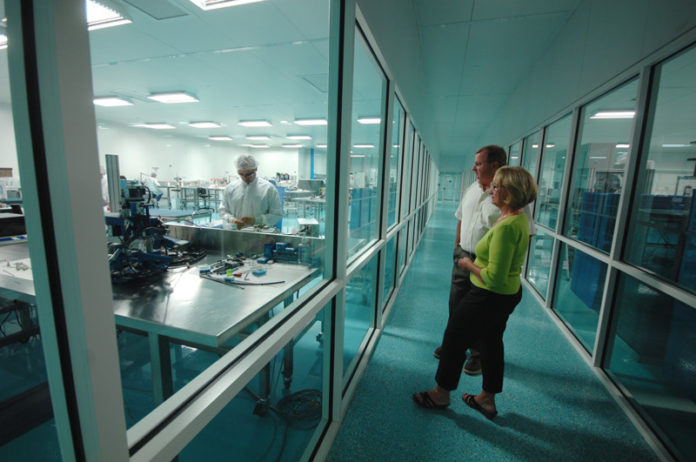
Biomedical Structures in Warwick manufactures in certified clean rooms for one critical reason.
“Everything we manufacture is intended to be surgically implanted in the human body,” said Vice President John Gray.
“We develop and manufacture textile structures for the medical-device world and that’s been growing fantastically for the last 11 years,” said Gray, one of company’s founders in 2002.
Biomedical and other Rhode Island manufacturers, including HTP-Meds in Hopkinton, that have embarked on innovative paths related to the medical industry are a sign of the state’s diversification and innovation, says Bill McCourt, executive director of the Rhode Island Manufacturers Association.
“Some people think the textile industry in Rhode Island is dying, but these companies are looking at needs in the marketplace and taking their existing expertise and capabilities and applying that to new markets,” said McCourt.
“In the medical applications, these individual business owners have seen opportunities and taken it upon themselves to go one step further,” McCourt said.
Biomedical Structures works in collaboration with medical-equipment manufacturers to design, develop and manufacture products, including sutures, knit products for hernia repair and woven structures for orthopedic applications.
“We help our customers design fabrics or textile structures and we’ll work with them to develop the product, which belongs to them,” he said. “Then there’s product development and validation and our customer works with the FDA to get the product approved.”
The process for new medical devices to go through testing and regulatory approvals can take years.
“Then they come back to us for production,” said Gray.
Biomedical Structures launched in the village of Slatersville in North Smithfield with a bioabsorbable nonwoven material used for a tissue engineering application, said Gray.
Tissue engineering is an emerging segment that is growing slowly, he said.
“Synthetic scaffolds are used as frameworks to form replacement tissues and, perhaps someday, regenerate entire organs from a patient’s own cells,” according to a Nov. 12, 2012 article by Mike Williams titled, “Smart Scaffolding Aims to Rebuild Tissues from the Inside.” Once their work is done, the scaffolds are designed to degrade and leave only natural, healthy tissue behind.” according to the article, published by Rice University.
Since that first material produced 11 years ago Biomedical Structures, a contract manufacturer, has substantially broadened its work in the medical-textile industry.
Biomedical has expanded its breadth of collaboration and development of medical applications, as well as expanding through merger and acquisition.
When the company outgrew its original Slatersville location, it moved to Warwick. It has since acquired a second facility in Warwick that came along with the acquisition of Concordia Medical in 2011.
The company now operates out of its two Warwick facilities – one 10,000 square feet and the other 35,000 square feet.
Biomedical Structures merged earlier this year with Modified Polymer Components of Sunnyvale, Calif.
“With Modified Polymer, we now have a West Coast presence,” said Gray. “Part of our growth strategy is to grow organically, as well as through mergers and acquisitions, which broadens our technological offerings.
“It’s interesting how the human body is finite, yet the applications we are asked to build are seemingly infinite,” he said.
Growth is one of the guiding forces at HTP-Meds, which specializes in medical-tubing services and products, with facilities in-house to design and cut the tooling. The company’s custom services and products include PORTs, dilators and precision tubing for catheters.
The company’s growth has been dramatic during its six years in business.
“We were about doubling the first three years,” said Quinlan.
“We did about $6.7 million in sales last year and our first six months this year is a record,” said Quinlan. “The forecast for our medical sales for 2013 would be about $9 million.”
HTP-Meds has 75 employees and like Biomedical Structures, which declined to say how many people it employs, company owners said they have almost no turnover in their well-trained and highly skilled workforce.
At HTP-Meds, there’s promise of continued growth with new product lines, said Quinlan.
“I think we could see growth of possibly 50 percent by the end of next year,” said Quinlan.
The visible external interest is a sign that HTP-Meds is doing a lot of things right.
“We get so much pressure from people wanting to buy the company all the time,” said Quinlan.
HTP-Meds is one of three related companies that moved from Stonington, Conn., to Rhode Island in 2008. The original company founded by Quinlan and Vice President of Finance Lydia Teixeira was Hi-Tech Profiles. The two spinoffs are Hi-Tech Molding and HTP-Meds. The supportive nature of the three companies allows HTP-Meds to provide faster and broader response to customer needs, because HTP-Meds can provide services from engineering and design to tooling and manufacturing, Quinlan said.
Despite the long process from concept to market, HTP-Meds has established a solid national and international customer base in the medical manufacturing industry that is expected to grow substantially.
“Last year we had about 436 products, but you won’t see them on the market for three-to-five years,” said Quinlan. “There’s validation and clinical trials before a new device can get on the market.” •












